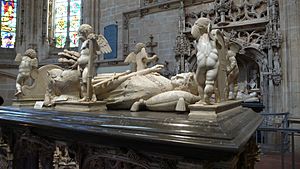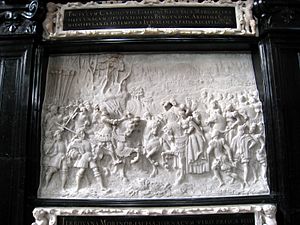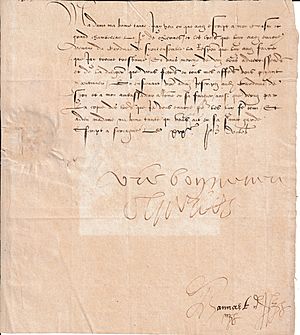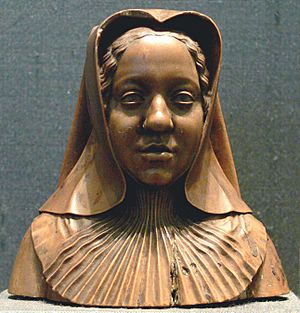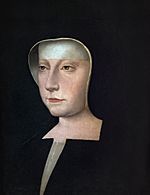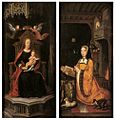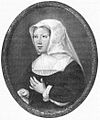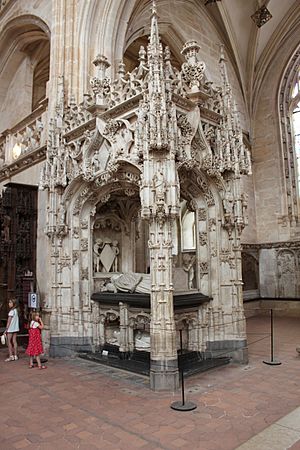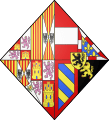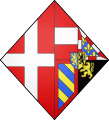Margaret of Austria, Duchess of Savoy facts for kids
Quick facts for kids Margaret of Austria |
|
|---|---|
| Princess of Asturias | |
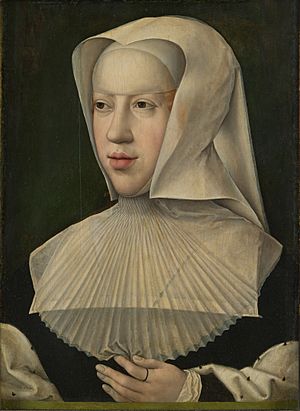
Portrait of Margaret as a widow painted by Bernard van Orley
|
|
| Duchess consort of Savoy | |
| Tenure | 2 December 1501 - 10 September 1504 |
| Governor of the Habsburg Netherlands | |
| Reign | 1507–1515 |
| Predecessor | William de Croÿ |
| Successor | Mary of Austria |
| Born | 10 January 1480 |
| Died | 1 December 1530 (aged 50) Mechelen, Duchy of Brabant |
| Spouse |
|
| House | Habsburg |
| Father | Maximilian I, Holy Roman Emperor |
| Mother | Mary, Duchess of Burgundy |
| Religion | Roman Catholic |
| Signature | |
Margaret of Austria (born January 10, 1480 – died December 1, 1530) was a very important leader in Europe during her time. She served as the Governor of the Habsburg Netherlands twice, first from 1507 to 1515, and then again from 1519 until her death in 1530. She was the first woman to hold such a high leadership position in the Netherlands.
Contents
Growing Up in France
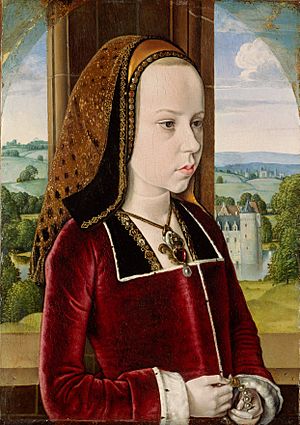
Margaret was born on January 10, 1480. She was the only daughter of Maximilian of Austria and Mary of Burgundy. Her parents ruled the Low Countries, which is an area in Europe that includes modern-day Belgium, Netherlands, and Luxembourg.
When Margaret was just two years old, her mother passed away. Her younger brother, Philip the Handsome, became the new ruler of the Low Countries. Their father, Maximilian, helped him rule as a regent.
In the same year her mother died, King Louis XI of France made a deal. He promised that Margaret would marry his son, Charles, who was the Dauphin of France (the heir to the French throne). Margaret was very young, but this was a common way to make alliances between powerful families.
As part of the deal, Margaret brought land, Franche-Comté and Artois, as her dowry (a gift from her family to the groom's family). She then moved to France to live under the care of King Louis XI. He died soon after, and Margaret was raised as a "fille de France," meaning she was treated like a French princess and prepared to become the future Queen of France.
Margaret received an excellent education. She studied alongside other noble children, including Louise of Savoy. She learned many things that would help her in her future role.
Even though their marriage was for political reasons, Margaret grew to like Charles very much. However, in 1491, Charles broke their engagement. He decided to marry Anne of Brittany instead, for his own political reasons. This made Margaret very sad and angry. She felt hurt by Charles's actions and held a strong dislike for the French royal family for a long time. She couldn't return home until 1493, after a new peace treaty was signed.
Her Marriages
Princess of Asturias
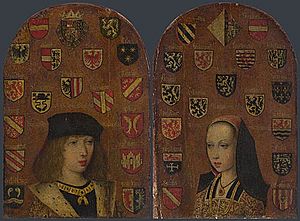
To create a strong alliance, Margaret's father, Maximilian, arranged two important marriages. Margaret would marry John, Prince of Asturias, who was the only son and heir of Queen Isabella I of Castile and King Ferdinand II of Aragon of Spain. At the same time, John's sister, Juana, would marry Margaret's brother, Philip.
Margaret set sail for Spain in late 1496. Her journey was very difficult. Her ship was caught in a terrible storm in the Bay of Biscay. Thinking she might not survive, she wrote her own epitaph (a short text for a tombstone):
"Here lies Margaret, the willing bride,
Twice married - but a virgin when she died."
Luckily, Margaret survived the storm and reached Spain. She married Prince John on April 3, 1497, in Burgos Cathedral. Sadly, their happiness did not last long. Prince John died of a fever just six months later, on October 4. Margaret was pregnant, but she gave birth to a baby girl who was born too early and did not survive.
Duchess of Savoy
In 1501, Margaret married again. Her second husband was Philibert II, Duke of Savoy. Savoy was a very important region because of its location in the Western Alps, which was key in the struggles between France and the Habsburg family.
Margaret and Philibert had a very loving relationship during their three years of marriage. When Margaret arrived in Savoy, Philibert's half-brother, René, held a lot of power. Margaret worked hard to take away his power and possessions. She even got her father, Maximilian, involved to help her. René was declared a traitor and fled to France.
Margaret then took charge of the government in Savoy. Her husband, Philibert, preferred to spend his time hunting, which Margaret also enjoyed. She held important meetings, appointed officials, and even discussed plans with her brother Philip when he visited.
Sadly, Philibert died in 1504 from an illness. Margaret was heartbroken. She was so sad that she tried to jump out of a window, but she was saved. She had Philibert's heart preserved so she could keep it with her always. Her court historian called her "Dame de deuil," which means "Lady of Mourning."
Leading the Habsburg Netherlands
After Queen Isabella of Spain died in 1504, Margaret's brother Philip and his wife Juana went to Spain to claim the throne. When Philip died, Margaret's young nephew, Charles, became the new ruler of the Low Countries. Charles was very young and needed someone to guide him. His mother, Juana, was not able to rule the kingdom.
Margaret's father, Maximilian I, who was the Holy Roman Emperor, decided to name Margaret as the Governor of the Low Countries in 1507. She also became the guardian of Charles and her nieces, Eleanor, Isabella, and Mary. She was the only woman ever chosen to rule the region of Franche-Comté by its representatives.
Margaret was a very successful leader. She acted as a link between her father and her nephew's subjects in the Netherlands. She worked from her new palace in Mechelen. She was seen as a local leader, unlike her father, who was sometimes seen as a foreigner.
In 1520, Charles made Margaret his governor-general again, showing how much he trusted her. She was the only regent he ever reappointed for an unlimited time, and she served until her death in 1530.
Historians believe Margaret acted like a queen for her father and then for Charles V. They were often away, so she represented them and helped manage their lands. She was a skilled diplomat and peace-maker. She also took care of and educated future rulers. This way of ruling helped the Habsburg family manage their large empire. Because she was an older relative and had been Charles's guardian, she had more influence with him than she did with her father.
Margaret is also credited with keeping the different provinces of the Low Countries united. She also helped meet the demands for peace from the people of the Netherlands. Even when other rulers tried to cause trouble, Margaret worked with her councils and the Estates General (a type of parliament) to keep the region strong and together.
Dealing with Other Countries
Margaret soon found herself in conflict with France. The French king wanted Charles to pay homage (show respect and loyalty) for the County of Flanders, which was part of the Low Countries but also considered part of France. Margaret convinced her father, Emperor Maximilian, to end the war with King Louis XII.
In 1508, she traveled to Cambrai to help create the League of Cambrai. This agreement stopped France from invading the Low Countries for a while and made France focus on Italy instead.
The people of the Netherlands wanted peace with France and Guelders (another region). But Charles of Egmont, the ruler of Guelders, kept causing problems. In 1511, Margaret made an alliance with England and tried to capture a town called Venlo. However, Charles of Egmont invaded Holland, so the attack had to be stopped.
When Margaret asked her father for help, he suggested that the Low Countries should defend themselves. This forced her to sign a treaty in 1513 that recognized Charles of Egmont as the Duke of Guelders. But he broke the treaty in 1514. The Habsburg Netherlands would only fully control Guelders later, under Charles V.
Margaret believed that the Netherlands depended on peace and trade. So, she declared that the Low Countries would remain neutral in wars. She played a key role in bringing together the Holy League, which included the Pope, the Swiss, King Henry VIII of England, Ferdinand of Aragon, and her father Maximilian. This alliance was against France.
In 1513, Maximilian, leading Henry VIII's army, won a battle against the French. This victory cost Margaret and the Low Countries very little. In fact, Margaret said the Low Countries made a lot of money by supplying the English army. Maximilian also ordered the walls of a French stronghold to be destroyed, which had often been used by the French to interfere in the Low Countries.
After Maximilian I died in 1518, Margaret and young Charles (who was 18) began to work on getting Charles elected as the Holy Roman Emperor. Margaret supported her younger nephew Ferdinand at first, but Charles insisted on running. Using smart diplomacy and some payments, Margaret played a crucial role in Charles's election as Holy Roman Emperor in 1519. He defeated King Francis I of France, who then became Charles's biggest rival in Europe.
As Emperor, Charles V had ongoing disagreements with the French kings over control of lands like Milan and Naples. Charles loved the Netherlands, but his many kingdoms and wars meant he had to travel all over Europe.
In 1525, Charles won a great victory against Francis I at the Battle of Pavia. He captured the French King and later freed him in exchange for Francis's sons as hostages. But once Francis was safely back in France, he broke his promises. This led to another French invasion of the Low Countries.
Once again, Margaret proved to be a very capable ruler. She held off the French forces and then negotiated the "Paix de Dames" (Ladies' Peace). Margaret met with Louise of Savoy, Francis I's mother, in Cambrai. They negotiated an end to the war that France could no longer afford. The Habsburgs lost some land, but France gave up its claims to rule Flanders, Artois, and the "Free County" of Burgundy (Franche-Comté).
Economy and Trade
Margaret was very good at business. She helped the Netherlands stay wealthy and successful. She negotiated a trade agreement with England called the Intercursus Magnus, which was very good for the textile industry in Flanders and brought in huge profits. Because of its trade, industry, and wealth, the Low Countries was an important source of money for the Emperor's treasury.
In 1524, she signed a trade agreement with Frederick I of Denmark. This deal made sure that grain would regularly be supplied to the Netherlands. Even when Charles V wanted her to support a different Danish king for family reasons, Margaret refused. She insisted on putting the economic interests of the Netherlands first.
Margaret also provided money and war supplies for her nephew's armies, especially against the French King Francis I and the German Protestants. In the years that followed, the Habsburg forces took control of more areas like Tournai, Friesland, Utrecht, and Overijssel, making them part of the Netherlands.
Challenges at Home
Even though the Low Countries were not fully united before Margaret, her time as ruler was mostly peaceful. The main challenge was the start of the Protestant Reformation, especially in the northern parts. The first people to be executed for their Protestant beliefs were in 1523.
Supporting the Arts
Once she became Governor of the Netherlands, Margaret bought a palace in Mechelen called the Hof van Savoye. She found it too small and began a big project to make it larger in 1507. From 1517 to 1530, an architect named Rombout II Keldermans continued the work. Her palace became one of the first Renaissance buildings in northern Europe.
Margaret had many painters working at her court. She also had a very large and valuable library filled with books on poetry, history, and ethics. She owned famous books like the Très Riches Heures du duc de Berry, which was a beautifully illustrated manuscript. She also had many music books with works by famous composers like Josquin des Prez and Pierre de la Rue, who was her favorite.
Margaret raised her nephew and nieces in her palace. Many important thinkers of her time visited her court, including Erasmus and Heinrich Cornelius Agrippa. Agrippa even dedicated his book about the importance of women to her.
Margaret was so impressed by the charm of a diplomat named Thomas Boleyn, 1st Earl of Wiltshire that she offered his daughter, Anne Boleyn (who later became Queen of England), a temporary place in her household. Margaret wrote to Thomas Boleyn that Anne was "so presentable and so pleasant, considering her youthful age, that I am more beholden to you for sending her to me, than you to me."
Margaret also ordered beautiful music manuscripts to give as gifts to her family and political allies. She had one of the earliest collections of items from the New World. In 1519, Hernán Cortés gave Charles V treasures from the Aztec King Moctezuma. Some of these treasures were sent to Mechelen as a gift from Charles to Margaret in 1523.
Portraits of Margaret
Her Death and Burial

On November 15, 1530, Margaret accidentally stepped on a piece of broken glass. At first, she didn't think much of the injury. But it became infected, and her leg had to be amputated. Before the operation, she made sure all her affairs were in order. She named Charles V as her only heir and wrote him a letter asking him to keep peace with France and England. She passed away between midnight and one o'clock on November 30, 1530.
Margaret was buried next to her second husband, Philibert, at the Royal Monastery of Brou in Bourg-en-Bresse. She had ordered this beautiful mausoleum to be built herself. There is also a statue of Margaret in Mechelen, Belgium, near the St. Rumbold's Cathedral.
Heraldry
Margaret in Media
Margaret of Austria is played by Spanish actress Úrsula Corberó in the TV show Isabel.
A made-up version of Margaret appears in a play called The Unhappy Penitent by Catharine Trotter. In the play, she is called 'Margarite' and is in love with someone she likely never met in real life.
See also
 In Spanish: Margarita de Austria (1480-1530) para niños
In Spanish: Margarita de Austria (1480-1530) para niños


